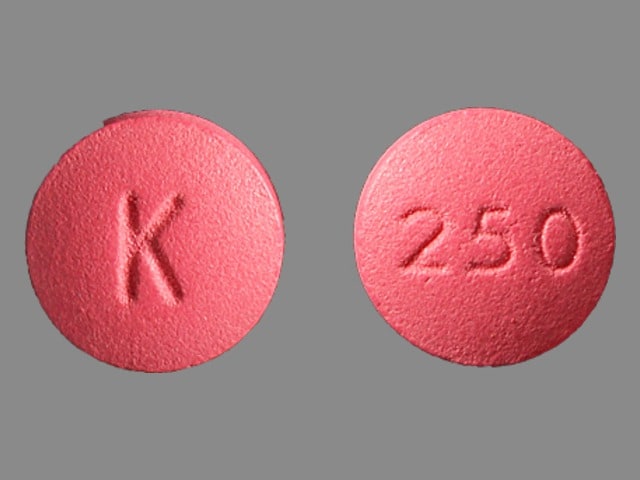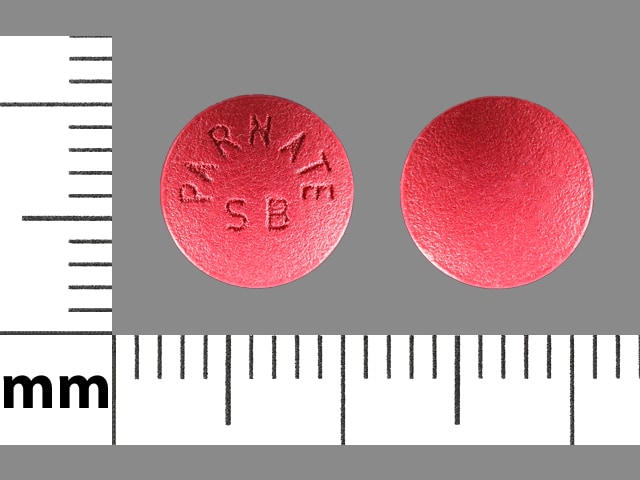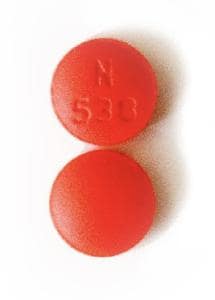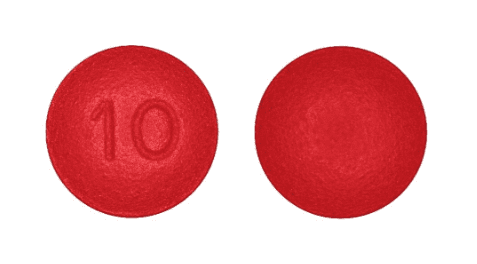Boxed Warning
Suicidal thoughts and behaviors:
Antidepressants increased the risk of suicidal thoughts and behaviors in pediatric and young adult patients in short-term studies. Closely monitor all antidepressant-treated patients for clinical worsening, and for emergence of suicidal thoughts and behaviors. Tranylcypromine is not approved for use in pediatric patients.
Hypertensive crisis with significant tyramine use:
Excessive consumption of foods or beverages with significant tyramine content or the use of certain drugs with tranylcypromine or after tranylcypromine discontinuation can precipitate hypertensive crisis. Monitor blood pressure and allow for medication-free intervals between administration of tranylcypromine and interacting drugs. Instruct patients to avoid ingestion of foods and beverages with high tyramine content.
Dosage Forms
Excipient information presented when available (limited, particularly for generics); consult specific product labeling.
Tablet, Oral:
Parnate: 10 mg [contains fd&c blue #2 (indigotine), fd&c red #40, fd&c yellow #6 (sunset yellow)]
Generic: 10 mg
Pharmacology
Mechanism of Action
Tranylcypromine is a nonhydrazine monoamine oxidase inhibitor. It increases endogenous concentrations of epinephrine, norepinephrine, and serotonin through inhibition of the enzyme (monoamine oxidase) responsible for the breakdown of these neurotransmitters.
Pharmacokinetics/Pharmacodynamics
Absorption
Rapid (Mallinger 1990)
Time to Peak
Serum: 1.5 hours (Mallinger 1990)
Duration of Action
MAO inhibition may persist for up to 10 days following discontinuation.
Half-Life Elimination
2.5 hours (Mallinger 1990)
Use: Labeled Indications
Major depressive disorder (unipolar): Treatment of major depressive disorder in adult patients who have not responded adequately to other antidepressants.
Contraindications
Pheochromocytoma or other catecholamine-releasing paragangliomas because such tumors secrete pressor substances and can lead to hypertensive crisis; concurrent use or use in rapid succession with non-selective H1 receptor antagonists, antidepressants (including but not limited to other monoamine oxidase inhibitors, selective serotonin reuptake inhibitors, and serotonin and norepinephrine reuptake inhibitors, tricyclic antidepressants, amoxapine, bupropion, maprotiline, nefazodone, trazodone, vilazodone, vortioxetine), amphetamines and methylphenidates and derivatives, sympathomimetic products (eg, products containing pseudoephedrine, phenylephrine, and ephedrine or dietary supplements that contain sympathomimetics), triptans, buspirone, carbamazepine, cyclobenzaprine, dextromethorphan, dopamine, hydroxytryptophan, levodopa, meperidine, methyldopa, milnacipran, rasagiline, reserpine, s-adenosyl-L-methionine (SAM-e), tapentadol, tetrabenazine, tryptophan
Canadian labeling: Additional contraindications (not in US labeling): Hypersensitivity to tranylcypromine or any component of the formulation; blood dyscrasias; cerebrovascular or cardiovascular disorders (eg, arteriosclerosis, hypertension); history of recurrent or frequent headaches; liver damage; foods and beverages with high tyramine content.
Documentation of allergenic cross-reactivity for monoamine oxidase inhibitors is limited. However, because of similarities in chemical structure and/or pharmacologic actions, the possibility of cross-sensitivity cannot be ruled out with certainty.
Dosage and Administration
Dosing: Adult
Major depressive disorder (unipolar): Oral: Initial: 10 to 30 mg/day, in divided doses; if symptoms do not improve after 2 weeks, increase dose by 10 mg/day increments at 1- to 3-week intervals; maximum dose: 60 mg/day; usual dosage range 30 to 60 mg/day in divided doses (APA 2010; McGrath 2006).
Discontinuation of therapy: When discontinuing antidepressant treatment that has lasted for >3 weeks, gradually taper the dose (eg, over 2 to 4 weeks) to minimize withdrawal symptoms and detect reemerging symptoms (APA 2010; WFSBP [Bauer 2015]). Reasons for a slower titration (eg, over 4 weeks) include use of a drug with a half-life <24 hours (eg, paroxetine, venlafaxine), prior history of antidepressant withdrawal symptoms, or high doses of antidepressants (APA 2010; Hirsch 2019). More severe symptoms have been associated with MAOIs; more conservative tapers may be necessary (Haddad 2001; Shelton 2001). If intolerable withdrawal symptoms occur, resume the previously prescribed dose and/or decrease dose at a more gradual rate (Shelton 2001). Select patients (eg, those with a history of discontinuation syndrome) on long-term treatment (>6 months) may benefit from tapering over >3 months (WFSBP [Bauer 2015]). Evidence supporting ideal taper rates is limited (Shelton 2001; WFSBP [Bauer 2015]).
MAO inhibitor recommendations:
Switching to or from an MAO inhibitor intended to treat psychiatric disorders:
Allow 14 days to elapse between discontinuing an alternative antidepressant without long half-life metabolites (eg, TCAs, paroxetine, fluvoxamine, venlafaxine) or MAO inhibitor intended to treat psychiatric disorders and initiation of tranylcypromine.
Allow at least 5 to 6 weeks to elapse between discontinuing fluoxetine (with long half-life metabolites) intended to treat psychiatric disorders and initiation of tranylcypromine.
Allow at least 7 to 14 days to elapse between discontinuing tranylcypromine and initiation of an alternative antidepressant or MAO inhibitor intended to treat psychiatric disorders (APA 2010).
Dosing: Geriatric
Refer to adult dosing; initiate therapy using lower doses with more gradual dose increases.
Dietary Considerations
Avoid tyramine-containing foods/beverages in conjunction with tranylcypromine (or within 2 weeks of stopping therapy). Some examples include aged or matured cheese, air-dried or cured meats (including sausages and salami), fava or broad bean pods, tap/draft beers, Marmite concentrate, sauerkraut, soy sauce and other soybean condiments. Food's freshness is also an important concern; improperly stored or spoiled food can create an environment where tyramine concentrations may increase (Walker 1996).
Storage
Store at 15°C to 30°C (59°F to 86°F). Protect from light.
Tranylcypromine Images
Drug Interactions
Acetylcholinesterase Inhibitors: May diminish the therapeutic effect of Anticholinergic Agents. Anticholinergic Agents may diminish the therapeutic effect of Acetylcholinesterase Inhibitors. Monitor therapy
Aclidinium: May enhance the anticholinergic effect of Anticholinergic Agents. Avoid combination
Alcohol (Ethyl): May enhance the adverse/toxic effect of Monoamine Oxidase Inhibitors. Avoid combination
Alfuzosin: May enhance the hypotensive effect of Blood Pressure Lowering Agents. Monitor therapy
Alosetron: May enhance the serotonergic effect of Serotonergic Agents (High Risk). This could result in serotonin syndrome. Management: Monitor for signs and symptoms of serotonin syndrome/serotonin toxicity (eg, hyperreflexia, clonus, hyperthermia, diaphoresis, tremor, autonomic instability, mental status changes) when these agents are combined. Monitor therapy
Alpha-/Beta-Agonists (Indirect-Acting): Monoamine Oxidase Inhibitors may enhance the hypertensive effect of Alpha-/Beta-Agonists (Indirect-Acting). While linezolid is expected to interact via this mechanism, management recommendations differ from other monoamine oxidase inhibitors. Refer to linezolid specific monographs for details. Avoid combination
Alpha1-Agonists: Monoamine Oxidase Inhibitors may enhance the hypertensive effect of Alpha1-Agonists. While linezolid is expected to interact via this mechanism, management recommendations differ from other monoamine oxidase inhibitors. Refer to linezolid specific monographs for details. Avoid combination
Altretamine: May enhance the orthostatic hypotensive effect of Monoamine Oxidase Inhibitors (Antidepressant). Monitor therapy
Amantadine: May enhance the anticholinergic effect of Anticholinergic Agents. Monitor therapy
Amifampridine: Agents With Seizure Threshold Lowering Potential may enhance the neuroexcitatory and/or seizure-potentiating effect of Amifampridine. Monitor therapy
Amifostine: Blood Pressure Lowering Agents may enhance the hypotensive effect of Amifostine. Management: When amifostine is used at chemotherapy doses, blood pressure lowering medications should be withheld for 24 hours prior to amifostine administration. If blood pressure lowering therapy cannot be withheld, amifostine should not be administered. Consider therapy modification
Amphetamines: Monoamine Oxidase Inhibitors may enhance the hypertensive effect of Amphetamines. While linezolid and tedizolid may interact via this mechanism, management recommendations differ from other monoamine oxidase inhibitors. Refer to monographs specific to those agents for details. Avoid combination
Anticholinergic Agents: May enhance the adverse/toxic effect of other Anticholinergic Agents. Monitor therapy
Antiemetics (5HT3 Antagonists): May enhance the serotonergic effect of Serotonergic Agents (High Risk). This could result in serotonin syndrome. Management: Monitor for signs and symptoms of serotonin syndrome/serotonin toxicity (eg, hyperreflexia, clonus, hyperthermia, diaphoresis, tremor, autonomic instability, mental status changes) when these agents are combined. Exceptions: Alosetron; Ondansetron; Ramosetron. Monitor therapy
Antipsychotic Agents: Serotonergic Agents (High Risk) may enhance the adverse/toxic effect of Antipsychotic Agents. Specifically, serotonergic agents may enhance dopamine blockade, possibly increasing the risk for neuroleptic malignant syndrome. Antipsychotic Agents may enhance the serotonergic effect of Serotonergic Agents (High Risk). This could result in serotonin syndrome. Monitor therapy
Antipsychotic Agents (Second Generation [Atypical]): Blood Pressure Lowering Agents may enhance the hypotensive effect of Antipsychotic Agents (Second Generation [Atypical]). Monitor therapy
Apraclonidine: Monoamine Oxidase Inhibitors may enhance the adverse/toxic effect of Apraclonidine. Monoamine Oxidase Inhibitors may increase the serum concentration of Apraclonidine. Avoid combination
AtoMOXetine: Monoamine Oxidase Inhibitors may enhance the neurotoxic (central) effect of AtoMOXetine. Avoid combination
Atropine (Ophthalmic): Monoamine Oxidase Inhibitors may enhance the hypertensive effect of Atropine (Ophthalmic). Avoid combination
Barbiturates: May enhance the hypotensive effect of Blood Pressure Lowering Agents. Monitor therapy
Benperidol: May enhance the hypotensive effect of Blood Pressure Lowering Agents. Monitor therapy
Benzhydrocodone: May enhance the serotonergic effect of Monoamine Oxidase Inhibitors. This could result in serotonin syndrome. Management: The use of benzhydrocodone is not recommended for patients taking monoamine oxidase inhibitors (MAOIs) or within 14 days of MAOI discontinuation. Consider therapy modification
Beta2-Agonists: Monoamine Oxidase Inhibitors may enhance the adverse/toxic effect of Beta2-Agonists. Monitor therapy
Betahistine: Monoamine Oxidase Inhibitors may increase the serum concentration of Betahistine. Monitor therapy
Bezafibrate: Monoamine Oxidase Inhibitors may enhance the adverse/toxic effect of Bezafibrate. Avoid combination
Blood Glucose Lowering Agents: Monoamine Oxidase Inhibitors may enhance the hypoglycemic effect of Blood Glucose Lowering Agents. Monitor therapy
Blood Pressure Lowering Agents: May enhance the hypotensive effect of Hypotension-Associated Agents. Monitor therapy
Botulinum Toxin-Containing Products: May enhance the anticholinergic effect of Anticholinergic Agents. Monitor therapy
Brexanolone: Tranylcypromine may enhance the CNS depressant effect of Brexanolone. Monitor therapy
Brimonidine (Ophthalmic): Monoamine Oxidase Inhibitors may enhance the adverse/toxic effect of Brimonidine (Ophthalmic). Monoamine Oxidase Inhibitors may increase the serum concentration of Brimonidine (Ophthalmic). Monitor therapy
Brimonidine (Topical): Monoamine Oxidase Inhibitors may enhance the adverse/toxic effect of Brimonidine (Topical). Monoamine Oxidase Inhibitors may increase the serum concentration of Brimonidine (Topical). Monitor therapy
Brimonidine (Topical): May enhance the hypotensive effect of Blood Pressure Lowering Agents. Monitor therapy
Bromperidol: Blood Pressure Lowering Agents may enhance the hypotensive effect of Bromperidol. Bromperidol may diminish the hypotensive effect of Blood Pressure Lowering Agents. Avoid combination
Buprenorphine: May enhance the adverse/toxic effect of Monoamine Oxidase Inhibitors. Avoid combination
BuPROPion: Monoamine Oxidase Inhibitors may enhance the hypertensive effect of BuPROPion. Avoid combination
BusPIRone: May enhance the serotonergic effect of Monoamine Oxidase Inhibitors (Antidepressant). This could result in serotonin syndrome. Avoid combination
Cannabinoid-Containing Products: Anticholinergic Agents may enhance the tachycardic effect of Cannabinoid-Containing Products. Exceptions: Cannabidiol. Monitor therapy
CarBAMazepine: May enhance the adverse/toxic effect of Monoamine Oxidase Inhibitors. Management: Avoid concurrent use of carbamazepine during, or within 14 days of discontinuing, treatment with a monoamine oxidase inhibitor. Avoid combination
Cerebrolysin: May enhance the adverse/toxic effect of Monoamine Oxidase Inhibitors. Monitor therapy
Chloral Betaine: May enhance the adverse/toxic effect of Anticholinergic Agents. Monitor therapy
Chlorphenesin Carbamate: May enhance the adverse/toxic effect of Monoamine Oxidase Inhibitors. Monitor therapy
Cimetropium: Anticholinergic Agents may enhance the anticholinergic effect of Cimetropium. Avoid combination
Clemastine: Monoamine Oxidase Inhibitors may enhance the anticholinergic effect of Clemastine. Monitor therapy
Cocaine (Topical): May enhance the adverse/toxic effect of Monoamine Oxidase Inhibitors. Monitor therapy
Codeine: Monoamine Oxidase Inhibitors may enhance the adverse/toxic effect of Codeine. Avoid combination
COMT Inhibitors: May enhance the adverse/toxic effect of Monoamine Oxidase Inhibitors. Consider therapy modification
Cyclobenzaprine: May enhance the serotonergic effect of Monoamine Oxidase Inhibitors. This could result in serotonin syndrome. Avoid combination
Cyproheptadine: Monoamine Oxidase Inhibitors may enhance the anticholinergic effect of Cyproheptadine. Cyproheptadine may diminish the serotonergic effect of Monoamine Oxidase Inhibitors. Avoid combination
Dapoxetine: May enhance the serotonergic effect of Serotonergic Agents (High Risk). This could result in serotonin syndrome. Management: Do not use serotonergic agents (high risk) with dapoxetine or within 7 days of serotonergic agent discontinuation. Do not use dapoxetine within 14 days of monoamine oxidase inhibitor use. Dapoxetine labeling lists this combination as contraindicated. Avoid combination
Deutetrabenazine: Monoamine Oxidase Inhibitors may enhance the adverse/toxic effect of Deutetrabenazine. Avoid combination
Dexmethylphenidate: Monoamine Oxidase Inhibitors may enhance the hypertensive effect of Dexmethylphenidate. Avoid combination
Dextromethorphan: Monoamine Oxidase Inhibitors may enhance the serotonergic effect of Dextromethorphan. This may cause serotonin syndrome. Avoid combination
Diazoxide: May enhance the hypotensive effect of Blood Pressure Lowering Agents. Monitor therapy
Diethylpropion: Monoamine Oxidase Inhibitors may enhance the hypertensive effect of Diethylpropion. Avoid combination
Dihydrocodeine: May enhance the serotonergic effect of Monoamine Oxidase Inhibitors. This could result in serotonin syndrome. Monitor therapy
Diphenoxylate: May enhance the hypertensive effect of Monoamine Oxidase Inhibitors. Avoid combination
Domperidone: Monoamine Oxidase Inhibitors may enhance the adverse/toxic effect of Domperidone. Monoamine Oxidase Inhibitors may diminish the therapeutic effect of Domperidone. Domperidone may diminish the therapeutic effect of Monoamine Oxidase Inhibitors. Monitor therapy
DOPamine: Monoamine Oxidase Inhibitors may enhance the hypertensive effect of DOPamine. Management: Initiate dopamine at no greater than one-tenth (1/10) of the usual dose in patients who are taking (or have taken within the last 2 to 3 weeks) monoamine oxidase inhibitors. Monitor for an exaggerated hypertensive response to dopamine. Consider therapy modification
Doxapram: Monoamine Oxidase Inhibitors may enhance the hypertensive effect of Doxapram. Monitor therapy
Doxylamine: Monoamine Oxidase Inhibitors may enhance the anticholinergic effect of Doxylamine. Management: The US manufacturer of Diclegis (doxylamine/pyridoxine) and the manufacturers of Canadian doxylamine products specifically lists use with monoamine oxidase inhibitors as contraindicated. Monitor therapy
Droxidopa: Monoamine Oxidase Inhibitors may enhance the hypertensive effect of Droxidopa. Avoid combination
Eluxadoline: Anticholinergic Agents may enhance the constipating effect of Eluxadoline. Avoid combination
EPINEPHrine (Nasal): Monoamine Oxidase Inhibitors may enhance the hypertensive effect of EPINEPHrine (Nasal). Monitor therapy
EPINEPHrine (Oral Inhalation): Monoamine Oxidase Inhibitors may enhance the hypertensive effect of EPINEPHrine (Oral Inhalation). Avoid combination
Epinephrine (Racemic): Monoamine Oxidase Inhibitors may enhance the hypertensive effect of Epinephrine (Racemic). Monitor therapy
EPINEPHrine (Systemic): Monoamine Oxidase Inhibitors may enhance the hypertensive effect of EPINEPHrine (Systemic). Monitor therapy
Ergot Derivatives: May enhance the serotonergic effect of Serotonergic Agents (High Risk). This could result in serotonin syndrome. Management: Monitor for signs and symptoms of serotonin syndrome/serotonin toxicity (eg, hyperreflexia, clonus, hyperthermia, diaphoresis, tremor, autonomic instability, mental status changes) when these agents are combined. Exceptions: Nicergoline. Monitor therapy
Esketamine: May enhance the hypertensive effect of Monoamine Oxidase Inhibitors. Monitor therapy
FentaNYL: May enhance the serotonergic effect of Monoamine Oxidase Inhibitors (Antidepressant). This could result in serotonin syndrome. Avoid combination
Gastrointestinal Agents (Prokinetic): Anticholinergic Agents may diminish the therapeutic effect of Gastrointestinal Agents (Prokinetic). Monitor therapy
Glucagon: Anticholinergic Agents may enhance the adverse/toxic effect of Glucagon. Specifically, the risk of gastrointestinal adverse effects may be increased. Monitor therapy
Glycopyrrolate (Oral Inhalation): Anticholinergic Agents may enhance the anticholinergic effect of Glycopyrrolate (Oral Inhalation). Avoid combination
Glycopyrronium (Topical): May enhance the anticholinergic effect of Anticholinergic Agents. Avoid combination
Guanethidine: May enhance the adverse/toxic effect of Monoamine Oxidase Inhibitors. Avoid combination
Herbs (Hypotensive Properties): May enhance the hypotensive effect of Blood Pressure Lowering Agents. Monitor therapy
Heroin: Monoamine Oxidase Inhibitors may enhance the adverse/toxic effect of Heroin. Avoid combination
HYDROcodone: Monoamine Oxidase Inhibitors may enhance the adverse/toxic effect of HYDROcodone. Management: Consider alternatives to this combination when possible. Consider therapy modification
HYDROmorphone: Monoamine Oxidase Inhibitors may enhance the adverse/toxic effect of HYDROmorphone. Avoid combination
Hypotension-Associated Agents: Blood Pressure Lowering Agents may enhance the hypotensive effect of Hypotension-Associated Agents. Monitor therapy
Indoramin: Monoamine Oxidase Inhibitors may enhance the hypotensive effect of Indoramin. Avoid combination
Iobenguane Radiopharmaceutical Products: Monoamine Oxidase Inhibitors may diminish the therapeutic effect of Iobenguane Radiopharmaceutical Products. Management: Discontinue all drugs that may inhibit or interfere with catecholamine transport or uptake for at least 5 biological half-lives before iobenguane administration. Do not administer these drugs until at least 7 days after each iobenguane dose. Avoid combination
Iohexol: Agents With Seizure Threshold Lowering Potential may enhance the adverse/toxic effect of Iohexol. Specifically, the risk for seizures may be increased. Management: Discontinue agents that may lower the seizure threshold 48 hours prior to intrathecal use of iohexol. Wait at least 24 hours after the procedure to resume such agents. In nonelective procedures, consider use of prophylactic anticonvulsants. Consider therapy modification
Iomeprol: Agents With Seizure Threshold Lowering Potential may enhance the adverse/toxic effect of Iomeprol. Specifically, the risk for seizures may be increased. Management: Discontinue agents that may lower the seizure threshold 48 hours prior to intrathecal use of iomeprol. Wait at least 24 hours after the procedure to resume such agents. In nonelective procedures, consider use of prophylactic anticonvulsants. Consider therapy modification
Iopamidol: Agents With Seizure Threshold Lowering Potential may enhance the adverse/toxic effect of Iopamidol. Specifically, the risk for seizures may be increased. Management: Discontinue agents that may lower the seizure threshold 48 hours prior to intrathecal use of iopamidol. Wait at least 24 hours after the procedure to resume such agents. In nonelective procedures, consider use of prophylactic anticonvulsants. Consider therapy modification
Ipratropium (Oral Inhalation): May enhance the anticholinergic effect of Anticholinergic Agents. Avoid combination
Isometheptene: Monoamine Oxidase Inhibitors may enhance the adverse/toxic effect of Isometheptene. Avoid combination
Itopride: Anticholinergic Agents may diminish the therapeutic effect of Itopride. Monitor therapy
Lasmiditan: May enhance the serotonergic effect of Serotonergic Agents (High Risk). This could result in serotonin syndrome. Management: Monitor for signs and symptoms of serotonin syndrome/serotonin toxicity (eg, hyperreflexia, clonus, hyperthermia, diaphoresis, tremor, autonomic instability, mental status changes) when these agents are combined. Monitor therapy
Levodopa-Containing Products: May enhance the adverse/toxic effect of Monoamine Oxidase Inhibitors. Of particular concern is the development of hypertensive reactions when levodopa is used with nonselective MAOI. Avoid combination
Levomethadone: May enhance the adverse/toxic effect of Monoamine Oxidase Inhibitors. Avoid combination
Levonordefrin: Monoamine Oxidase Inhibitors may enhance the hypertensive effect of Levonordefrin. Avoid combination
Levosulpiride: Anticholinergic Agents may diminish the therapeutic effect of Levosulpiride. Avoid combination
Linezolid: May enhance the serotonergic effect of Monoamine Oxidase Inhibitors (Antidepressant). This could result in serotonin syndrome. Avoid combination
Lithium: Monoamine Oxidase Inhibitors (Antidepressant) may enhance the serotonergic effect of Lithium. This could result in serotonin syndrome. Management: Consider alternatives to this drug combination. If combined, monitor for signs and symptoms of serotonin syndrome/serotonin toxicity (eg, hyperreflexia, clonus, hyperthermia, diaphoresis, tremor, autonomic instability, mental status changes). Consider therapy modification
Lorcaserin: May enhance the serotonergic effect of Serotonergic Agents (High Risk). This could result in serotonin syndrome. Management: Monitor for signs and symptoms of serotonin syndrome/serotonin toxicity (eg, hyperreflexia, clonus, hyperthermia, diaphoresis, tremor, autonomic instability, mental status changes) when these agents are combined. Monitor therapy
Lormetazepam: May enhance the hypotensive effect of Blood Pressure Lowering Agents. Monitor therapy
Maprotiline: May enhance the adverse/toxic effect of Monoamine Oxidase Inhibitors. Avoid combination
Meperidine: May enhance the serotonergic effect of Monoamine Oxidase Inhibitors (Antidepressant). This could result in serotonin syndrome. Avoid combination
Meptazinol: Monoamine Oxidase Inhibitors may enhance the adverse/toxic effect of Meptazinol. Avoid combination
Mequitazine: Monoamine Oxidase Inhibitors may enhance the anticholinergic effect of Mequitazine. Avoid combination
Metaraminol: Monoamine Oxidase Inhibitors may enhance the hypertensive effect of Metaraminol. Monitor therapy
Metaxalone: May enhance the serotonergic effect of Serotonergic Agents (High Risk). This could result in serotonin syndrome. Management: Monitor for signs and symptoms of serotonin syndrome/serotonin toxicity (eg, hyperreflexia, clonus, hyperthermia, diaphoresis, tremor, autonomic instability, mental status changes) when these agents are combined. Monitor therapy
Methadone: May enhance the serotonergic effect of Monoamine Oxidase Inhibitors. This could result in serotonin syndrome. Avoid combination
Methyldopa: Monoamine Oxidase Inhibitors may enhance the adverse/toxic effect of Methyldopa. Avoid combination
Methylene Blue: Monoamine Oxidase Inhibitors (Antidepressant) may enhance the serotonergic effect of Methylene Blue. This could result in serotonin syndrome. Avoid combination
Methylphenidate: Monoamine Oxidase Inhibitors may enhance the hypertensive effect of Methylphenidate. Avoid combination
Metoclopramide: May enhance the hypertensive effect of Monoamine Oxidase Inhibitors. Avoid combination
Mianserin: Monoamine Oxidase Inhibitors may enhance the neurotoxic effect of Mianserin. Avoid combination
Mirabegron: Anticholinergic Agents may enhance the adverse/toxic effect of Mirabegron. Monitor therapy
Molsidomine: May enhance the hypotensive effect of Blood Pressure Lowering Agents. Monitor therapy
Monoamine Oxidase Inhibitors (Antidepressant): May enhance the hypertensive effect of other Monoamine Oxidase Inhibitors (Antidepressant). Monoamine Oxidase Inhibitors (Antidepressant) may enhance the serotonergic effect of other Monoamine Oxidase Inhibitors (Antidepressant). This could result in serotonin syndrome. Avoid combination
Monoamine Oxidase Inhibitors (Type B): Monoamine Oxidase Inhibitors (Antidepressant) may enhance the hypertensive effect of Monoamine Oxidase Inhibitors (Type B). Monoamine Oxidase Inhibitors (Antidepressant) may enhance the serotonergic effect of Monoamine Oxidase Inhibitors (Type B). This could result in serotonin syndrome. Avoid combination
Morphine (Systemic): Monoamine Oxidase Inhibitors may enhance the adverse/toxic effect of Morphine (Systemic). Avoid combination
Naftopidil: May enhance the hypotensive effect of Blood Pressure Lowering Agents. Monitor therapy
Nefazodone: Monoamine Oxidase Inhibitors (Antidepressant) may enhance the serotonergic effect of Nefazodone. This could result in serotonin syndrome. Avoid combination
Nefopam: Monoamine Oxidase Inhibitors may enhance the adverse/toxic effect of Nefopam. Avoid combination
Nicergoline: May enhance the hypotensive effect of Blood Pressure Lowering Agents. Monitor therapy
Nicorandil: May enhance the hypotensive effect of Blood Pressure Lowering Agents. Monitor therapy
Nitroglycerin: Anticholinergic Agents may decrease the absorption of Nitroglycerin. Specifically, anticholinergic agents may decrease the dissolution of sublingual nitroglycerin tablets, possibly impairing or slowing nitroglycerin absorption. Monitor therapy
Nitroprusside: Blood Pressure Lowering Agents may enhance the hypotensive effect of Nitroprusside. Monitor therapy
Norepinephrine: Monoamine Oxidase Inhibitors may enhance the hypertensive effect of Norepinephrine. Monitor therapy
Normethadone: Monoamine Oxidase Inhibitors may enhance the adverse/toxic effect of Normethadone. Avoid combination
Obinutuzumab: May enhance the hypotensive effect of Blood Pressure Lowering Agents. Management: Consider temporarily withholding blood pressure lowering medications beginning 12 hours prior to obinutuzumab infusion and continuing until 1 hour after the end of the infusion. Consider therapy modification
Ondansetron: May enhance the serotonergic effect of Serotonergic Agents (High Risk). This could result in serotonin syndrome. Management: Monitor for signs and symptoms of serotonin syndrome/serotonin toxicity (eg, hyperreflexia, clonus, hyperthermia, diaphoresis, tremor, autonomic instability, mental status changes) when these agents are combined. Monitor therapy
Opioid Agonists: Anticholinergic Agents may enhance the adverse/toxic effect of Opioid Agonists. Specifically, the risk for constipation and urinary retention may be increased with this combination. Monitor therapy
Opioid Agonists: May enhance the serotonergic effect of Serotonergic Agents (High Risk). This could result in serotonin syndrome. Management: Monitor for signs and symptoms of serotonin syndrome/serotonin toxicity (eg, hyperreflexia, clonus, hyperthermia, diaphoresis, tremor, autonomic instability, mental status changes) when these agents are combined. Exceptions: FentaNYL; Meperidine; TraMADol. Monitor therapy
Opium: Monoamine Oxidase Inhibitors may enhance the adverse/toxic effect of Opium. Avoid combination
Oxatomide: May enhance the anticholinergic effect of Anticholinergic Agents. Avoid combination
Oxitriptan: Serotonergic Agents (High Risk) may enhance the serotonergic effect of Oxitriptan. This could result in serotonin syndrome. Management: Monitor for signs and symptoms of serotonin syndrome/serotonin toxicity (eg, hyperreflexia, clonus, hyperthermia, diaphoresis, tremor, autonomic instability, mental status changes) when these agents are combined. Monitor therapy
OxyCODONE: May enhance the serotonergic effect of Monoamine Oxidase Inhibitors. This could result in serotonin syndrome. Avoid combination
OxyMORphone: May enhance the adverse/toxic effect of Monoamine Oxidase Inhibitors. Avoid combination
Pentoxifylline: May enhance the hypotensive effect of Blood Pressure Lowering Agents. Monitor therapy
Pheniramine: May enhance the anticholinergic effect of Monoamine Oxidase Inhibitors. Avoid combination
Pholcodine: May enhance the serotonergic effect of Monoamine Oxidase Inhibitors. This could result in serotonin syndrome. Avoid combination
Phosphodiesterase 5 Inhibitors: May enhance the hypotensive effect of Blood Pressure Lowering Agents. Monitor therapy
Pizotifen: Monoamine Oxidase Inhibitors may enhance the anticholinergic effect of Pizotifen. Avoid combination
Potassium Chloride: Anticholinergic Agents may enhance the ulcerogenic effect of Potassium Chloride. Management: Patients on drugs with substantial anticholinergic effects should avoid using any solid oral dosage form of potassium chloride. Avoid combination
Potassium Citrate: Anticholinergic Agents may enhance the ulcerogenic effect of Potassium Citrate. Avoid combination
Pramlintide: May enhance the anticholinergic effect of Anticholinergic Agents. These effects are specific to the GI tract. Consider therapy modification
Prostacyclin Analogues: May enhance the hypotensive effect of Blood Pressure Lowering Agents. Monitor therapy
Quinagolide: May enhance the hypotensive effect of Blood Pressure Lowering Agents. Monitor therapy
Ramosetron: Anticholinergic Agents may enhance the constipating effect of Ramosetron. Monitor therapy
Ramosetron: May enhance the serotonergic effect of Serotonergic Agents (High Risk). This could result in serotonin syndrome. Management: Monitor for signs and symptoms of serotonin syndrome/serotonin toxicity (eg, hyperreflexia, clonus, hyperthermia, diaphoresis, tremor, autonomic instability, mental status changes) when these agents are combined. Monitor therapy
Reboxetine: Monoamine Oxidase Inhibitors may enhance the adverse/toxic effect of Reboxetine. Avoid combination
Remifentanil: Monoamine Oxidase Inhibitors may enhance the adverse/toxic effect of Remifentanil. Specifically, the risk for opioid toxicity (eg, respiratory depression) may be increased. Remifentanil may enhance the serotonergic effect of Monoamine Oxidase Inhibitors. This could result in serotonin syndrome. Management: The use of remifentanil is not recommended for patients taking monoamine oxidase inhibitors (MAOIs) or within 14 days of MAOI discontinuation. Consider therapy modification
Reserpine: Monoamine Oxidase Inhibitors may enhance the adverse/toxic effect of Reserpine. Existing MAOI therapy can result in paradoxical effects of added reserpine (e.g., excitation, hypertension). Management: Monoamine oxidase inhibitors (MAOIs) should be avoided or used with great caution in patients who are also receiving reserpine. Consider therapy modification
Revefenacin: Anticholinergic Agents may enhance the anticholinergic effect of Revefenacin. Avoid combination
Secretin: Anticholinergic Agents may diminish the therapeutic effect of Secretin. Management: Avoid concomitant use of anticholinergic agents and secretin. Discontinue anticholinergic agents at least 5 half-lives prior to administration of secretin. Consider therapy modification
Selective Serotonin Reuptake Inhibitors: May enhance the serotonergic effect of Monoamine Oxidase Inhibitors (Antidepressant). This could result in serotonin syndrome. Exceptions: Dapoxetine. Avoid combination
Serotonergic Non-Opioid CNS Depressants: May enhance the serotonergic effect of Monoamine Oxidase Inhibitors (Antidepressant). This could result in serotonin syndrome. Avoid combination
Serotonin 5-HT1D Receptor Agonists (Triptans): May enhance the serotonergic effect of Monoamine Oxidase Inhibitors. This could result in serotonin syndrome. Monoamine Oxidase Inhibitors may increase the serum concentration of Serotonin 5-HT1D Receptor Agonists (Triptans). Avoid combination
Serotonin/Norepinephrine Reuptake Inhibitors: Monoamine Oxidase Inhibitors (Antidepressant) may enhance the serotonergic effect of Serotonin/Norepinephrine Reuptake Inhibitors. This could result in serotonin syndrome. Avoid combination
Solriamfetol: Monoamine Oxidase Inhibitors may enhance the hypertensive effect of Solriamfetol. Avoid combination
St John's Wort: May enhance the serotonergic effect of Serotonergic Agents (High Risk). This could result in serotonin syndrome. St John's Wort may decrease the serum concentration of Serotonergic Agents (High Risk). Management: Monitor for signs and symptoms of serotonin syndrome/serotonin toxicity (eg, hyperreflexia, clonus, hyperthermia, diaphoresis, tremor, autonomic instability, mental status changes) when these agents are combined. Monitor therapy
SUFentanil: May enhance the adverse/toxic effect of Monoamine Oxidase Inhibitors. Specifically, the risk for serotonin syndrome or opioid toxicities (eg, respiratory depression, coma) may be increased. Management: Sufentanil should not be used with monoamine oxidase (MAO) inhibitors (or within 14 days of stopping an MAO inhibitor) due to the potential for serotonin syndrome and/or excessive CNS depression. Avoid combination
Syrian Rue: May enhance the serotonergic effect of Serotonergic Agents (High Risk). This could result in serotonin syndrome. Management: Monitor for signs and symptoms of serotonin syndrome/serotonin toxicity (eg, hyperreflexia, clonus, hyperthermia, diaphoresis, tremor, autonomic instability, mental status changes) when these agents are combined. Monitor therapy
Tapentadol: May enhance the adverse/toxic effect of Monoamine Oxidase Inhibitors. Specifically, the additive effects of norepinephrine may lead to adverse cardiovascular effects. Tapentadol may enhance the serotonergic effect of Monoamine Oxidase Inhibitors. This could result in serotonin syndrome. Avoid combination
Tetrabenazine: May enhance the adverse/toxic effect of Monoamine Oxidase Inhibitors. Avoid combination
Tetrahydrozoline (Nasal): Monoamine Oxidase Inhibitors may enhance the hypertensive effect of Tetrahydrozoline (Nasal). Avoid combination
Thiazide and Thiazide-Like Diuretics: Anticholinergic Agents may increase the serum concentration of Thiazide and Thiazide-Like Diuretics. Monitor therapy
Tianeptine: May enhance the adverse/toxic effect of Monoamine Oxidase Inhibitors. Avoid combination
Tiotropium: Anticholinergic Agents may enhance the anticholinergic effect of Tiotropium. Avoid combination
Topiramate: Anticholinergic Agents may enhance the adverse/toxic effect of Topiramate. Monitor therapy
TraMADol: Monoamine Oxidase Inhibitors (Antidepressant) may enhance the adverse/toxic effect of TraMADol. Specifically, the risk for serotonin syndrome/serotonin toxicity and seizures may be increased.. Avoid combination
Tricyclic Antidepressants: Monoamine Oxidase Inhibitors (Antidepressant) may enhance the serotonergic effect of Tricyclic Antidepressants. This could result in serotonin syndrome. Avoid combination
Tryptophan: Monoamine Oxidase Inhibitors (Antidepressant) may enhance the serotonergic effect of Tryptophan. This could result in serotonin syndrome. Avoid combination
Umeclidinium: May enhance the anticholinergic effect of Anticholinergic Agents. Avoid combination
Valbenazine: May enhance the adverse/toxic effect of Monoamine Oxidase Inhibitors. Avoid combination
Adverse Reactions
Frequency not defined.
Cardiovascular: Edema, orthostatic hypotension, palpitations, tachycardia
Central nervous system: Agitation, anxiety, chills, dizziness, drowsiness, headache, insomnia, mania, myoclonus, numbness, paresthesia, restlessness
Dermatologic: Diaphoresis, urticaria
Endocrine & metabolic: SIADH (syndrome of inappropriate antidiuretic hormone secretion)
Gastrointestinal: Abdominal pain, anorexia, constipation, diarrhea, nausea, xerostomia
Genitourinary: Sexual disorder (anorgasmia, ejaculatory disturbance, impotence), urinary retention
Hematologic & oncologic: Agranulocytosis, anemia, leukopenia, thrombocytopenia
Neuromuscular & skeletal: Muscle spasm, tremor, weakness
Ophthalmic: Blurred vision
Otic: Tinnitus
<1%, postmarketing, and/or case reports: Acne vulgaris (cystic acne), akinesia, alopecia, amnesia, ataxia, cheilitis (angular), confusion, disorientation, hepatitis, polyuria, scleroderma (localized), skin rash, urinary incontinence, withdrawal syndrome
Warnings/Precautions
Major psychiatric warnings:
- Suicidal thinking/behavior: [US Boxed Warning]: Antidepressants increase the risk of suicidal thinking and behavior in children, adolescents, and young adults (18 to 24 years of age) with major depressive disorder (MDD) and other psychiatric disorders; consider risk prior to prescribing. Short-term studies did not show an increased risk in patients >24 years of age and showed a decreased risk in patients ≥65 years. Closely monitor patients for clinical worsening, suicidality, or unusual changes in behavior, particularly during the initial 1 to 2 months of therapy or during periods of dosage adjustments (increases or decreases); the patient’s family or caregiver should be instructed to closely observe the patient and communicate condition with healthcare provider. A medication guide concerning the use of antidepressants should be dispensed with each prescription. Tranylcypromine is not approved for use in pediatric patients.
- The possibility of a suicide attempt is inherent in major depression and may persist until remission occurs. Worsening depression and severe abrupt suicidality that are not part of the presenting symptoms may require discontinuation or modification of drug therapy. Use caution in high-risk patients during initiation of therapy.
- Prescriptions should be written for the smallest quantity consistent with good patient care. The patient's family or caregiver should be alerted to monitor patients for the emergence of suicidality and associated behaviors such as anxiety, agitation, panic attacks, insomnia, irritability, hostility, impulsivity, akathisia, hypomania, and mania; patients should be instructed to notify their healthcare provider if any of these symptoms or worsening depression occur.
Concerns related to adverse effects:
- CNS depression: May cause CNS depression, which may impair physical or mental abilities; patients must be cautioned about performing tasks that require mental alertness (eg, operating machinery or driving).
- Hypertensive crisis: Cases of hypertensive crisis (sometimes fatal) have occurred; symptoms include: occipital headache which may radiate frontally, nausea/vomiting, neck stiffness/soreness, palpitation, photophobia, seizures, shortness of breath and sweating. Tachycardia and bradycardia may be present, and associated constricting chest pain and dilated pupils may occur. Monitor blood pressure closely in all patients; discontinue immediately if palpitation or frequent headaches occur. A history of headaches can mask the occurrence of headaches as prodromal of a hypertensive crisis. May occur with foods/supplements high in tyramine, tryptophan, phenylalanine, or tyrosine content. Clinically significant increases in blood pressure have also been reported after the administration of MAOIs in patients not ingesting tyramine-rich foods or beverages.
- Hypotension: May cause postural hypotension (especially at dosages >30 mg/day) and may result in syncope; use with caution in patients at risk of this effect, patents with preexisting hypertension, or in those who would not tolerate transient hypotensive episodes (cerebrovascular disease, cardiovascular disease, hypovolemia, or concurrent medication use which may predispose to hypotension/bradycardia). Increase dosage more gradually in patients showing a tendency toward hypotension.
- Intracranial bleeding: Intracranial bleeding (some fatal) have been reported in association with the paradoxical increase in blood pressure.
- Serotonin syndrome: Potentially life-threatening serotonin syndrome (SS) has occurred with serotonergic agents (eg, SSRIs, SNRIs), particularly when used in combination with other serotonergic agents (eg, triptans, TCAs, fentanyl, lithium, tramadol, buspirone, St John's wort, tryptophan) or agents that impair metabolism of serotonin (eg, MAO inhibitors intended to treat psychiatric disorders, other MAO inhibitors [ie, linezolid and intravenous methylene blue]). Monitor patients closely for signs of SS such as mental status changes (eg, agitation, hallucinations, delirium, coma); autonomic instability (eg, tachycardia, labile blood pressure, diaphoresis); neuromuscular changes (eg, tremor, rigidity, myoclonus); GI symptoms (eg, nausea, vomiting, diarrhea); and/or seizures. Discontinue treatment (and any concomitant serotonergic agent) immediately if signs/symptoms arise.
Disease-related concerns:
- Cardiovascular disease: Use with caution in patients with hypertension or confirmed or suspected cerebrovascular or cardiovascular disorders that constitute an increased risk for complications from severe hypertension.
- Diabetes: Use with caution in patients with diabetes mellitus; may increase the risk of hypoglycemic episodes, monitor blood glucose closely in diabetic patients receiving insulin or oral hypoglycemic agents.
- Drug abuse: Use with caution in patients with a history of drug abuse or acute alcoholism; potential for drug dependency may exist, especially in patients using doses exceeding the therapeutic range.
- Hepatic impairment: Monitor patients with cirrhosis for possible increased risks of central nervous system adverse effects such as drowsiness or sedation. Hepatitis and elevated aminotransferases have been reported with use; discontinue in patients who develop symptoms of hepatotoxicity.
- Mania/hypomania: May precipitate a shift to mania or hypomania in patients with bipolar disorder. Monotherapy in patients with bipolar disorder should be avoided. Patients presenting with depressive symptoms should be screened for bipolar disorder. Tranylcypromine is not approved for the treatment of bipolar depression.
- Seizure disorder: Use with caution in patients at risk for seizures; seizures have been reported with withdrawal after abuse and with overdose.
- Thyroid dysfunction: Use with caution in patients with hyperthyroidism; patients may have a greater risk for hypertensive crisis.
Concurrent drug therapy issues:
- Drug-drug interactions: Potentially significant interactions may exist, requiring dose or frequency adjustment, additional monitoring, and/or selection of alternative therapy. Consult drug interactions database for more detailed information.
Special populations:
- Surgical patients: Discontinue tranylcypromine use within 10 days prior to elective surgery. The decision to continue or withhold MAO inhibitors must be done in collaboration with the patient's psychiatrist. Currently, an MAO-safe anesthetic technique which excludes the use of meperidine and indirect-acting adrenergic agonists is recommended for patients requiring continued MAO inhibitor therapy (Huyse 2006).
Other warnings/precautions:
- Appropriate use: Tranylcypromine is not generally considered a first-line agent for the treatment of depression; tranylcypromine is typically used in patients who have failed to respond to other treatments. Risks of clinically significant adverse reactions may persist up to 10 days following discontinuation when considering potentially interacting substances, foods or beverages.
- Discontinuation syndrome: Abrupt discontinuation or interruption of antidepressant therapy has been associated with a discontinuation syndrome. Symptoms arising may vary with antidepressant however commonly include nausea, vomiting, diarrhea, headaches, lightheadedness, dizziness, diminished appetite, sweating, chills, tremors, paresthesias, fatigue, somnolence, and sleep disturbances (eg, vivid dreams, insomnia). Less common symptoms include electric shock-like sensations, cardiac arrhythmias (more common with tricyclic antidepressants), myalgias, parkinsonism, arthralgias, and balance difficulties. Psychological symptoms may also emerge such as agitation, anxiety, akathisia, panic attacks, irritability, aggressiveness, worsening of mood, dysphoria, mood lability, hyperactivity, mania/hypomania, depersonalization, decreased concentration, slowed thinking, confusion, and memory or concentration difficulties. Greater risks for developing a discontinuation syndrome have been associated with antidepressants with shorter half-lives, longer durations of treatment, and abrupt discontinuation. More severe symptoms have also been associated with MAO inhibitors. For antidepressants of short or intermediate half-lives, symptoms may emerge within 2 to 5 days after treatment discontinuation and last 7 to 14 days (APA 2010; Fava 2006; Haddad 2001; Shelton 2001; Warner 2006).
Monitoring Parameters
Blood glucose, renal and hepatic function; blood pressure, heart rate, mental status, worsening of depression, suicidality, or unusual changes in behavior (especially at the beginning of therapy or when doses are increased or decreased)
Pregnancy
Pregnancy Considerations
Information related to the use of tranylcypromine in pregnancy is limited (Kennedy 2017).
Pregnant women exposed to antidepressants during pregnancy are encouraged to enroll in the National Pregnancy Registry for Antidepressants (NPRAD). Women 18 to 45 years of age or their health care providers may contact the registry by calling 844-405-6185. Enrollment should be done as early in pregnancy as possible.
Patient Education
What is this drug used for?
- It is used to treat low mood (depression). It is most often given after other drugs have failed to help.
Frequently reported side effects of this drug
- Fatigue
- Constipation
- Trouble sleeping
- Dry mouth
- Anxiety
- Tremors
- Blurred vision
Other side effects of this drug: Talk with your doctor right away if you have any of these signs of:
- Depression like thoughts of suicide, anxiety, agitation, irritability, panic attacks, mood changes, behavioral changes, or confusion
- Liver problems like dark urine, fatigue, lack of appetite, nausea, abdominal pain, light-colored stools, vomiting, or yellow skin
- Low blood sugar like dizziness, headache, fatigue, feeling weak, shaking, fast heartbeat, confusion, increased hunger, or sweating
- Serotonin syndrome like dizziness, severe headache, agitation, sensing things that seem real but are not, fast heartbeat, abnormal heartbeat, flushing, tremors, sweating a lot, change in balance, severe nausea, or severe diarrhea
- Seizures
- Severe headache
- Severe dizziness
- Passing out
- Vision changes
- Signs of a significant reaction like wheezing; chest tightness; fever; itching; bad cough; blue skin color; seizures; or swelling of face, lips, tongue, or throat.
Note: This is not a comprehensive list of all side effects. Talk to your doctor if you have questions.
Consumer Information Use and Disclaimer: This information should not be used to decide whether or not to take this medicine or any other medicine. Only the healthcare provider has the knowledge and training to decide which medicines are right for a specific patient. This information does not endorse any medicine as safe, effective, or approved for treating any patient or health condition. This is only a brief summary of general information about this medicine. It does NOT include all information about the possible uses, directions, warnings, precautions, interactions, adverse effects, or risks that may apply to this medicine. This information is not specific medical advice and does not replace information you receive from the healthcare provider. You must talk with the healthcare provider for complete information about the risks and benefits of using this medicine.








